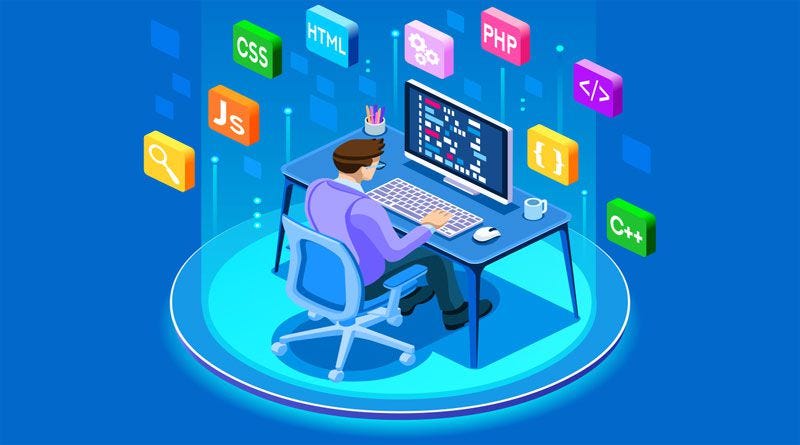
Introduction: Full-Stack Development in 2025—An Evolving Landscape
Full-stack development involves both the front-end and back-end of web development, and as technology advances, so do the tools, frameworks, and practices that make building modern applications faster and more efficient. In 2025, the role of a full-stack developer is more exciting than ever, with new trends and technologies transforming how developers create dynamic, responsive, and scalable web applications.
In this article, we’ll explore the top full-stack development trends to watch in 2025, from powerful new frameworks to the increasing importance of DevOps practices and serverless architectures. Let’s dive into the technologies that are driving innovation and shaping the future of web development.
1. Rise of Serverless Architecture for Full-Stack Development
Serverless computing, where the developer focuses solely on writing code and the cloud provider manages server infrastructure, has quickly become a go-to solution for building scalable applications. Popular platforms like AWS Lambda, Azure Functions, and Google Cloud Functions allow developers to build full-stack applications without worrying about server management.
Cost Efficiency: Serverless platforms use a pay-as-you-go model, meaning developers only pay for the resources their code uses, making it a cost-effective solution for projects with fluctuating traffic.
Scalability: Serverless functions automatically scale based on demand, which makes them ideal for handling large numbers of requests without manual intervention.
Faster Development Cycles: Serverless architecture frees developers from managing infrastructure, letting them focus on building features and improving application performance.
Why it matters: For full-stack developers, serverless architecture offers a streamlined, cost-effective way to build scalable applications, reducing the overhead of server management and speeding up development.
2. Microservices Architecture: The Future of Scalable Applications
Microservices have become a fundamental architectural pattern in webdevelopments.us. By breaking applications into small, independent services that communicate via APIs, developers can scale, maintain, and update individual components without affecting the entire application.
Independent Scalability: Each microservice can scale independently based on its workload, allowing teams to optimize resources more effectively.
Faster Updates and Maintenance: Microservices allow for continuous deployment of individual services, which speeds up updates and feature rollouts.
Resilience: Since each service operates independently, failure in one part of the application doesn’t bring down the whole system, improving overall resilience.
Why it matters: Microservices enable full-stack developers to build flexible, resilient, and scalable applications that can grow with user needs and integrate seamlessly with external services.
3. GraphQL: Transforming APIs for Full-Stack Developers
GraphQL is quickly replacing traditional REST APIs due to its ability to deliver more efficient data fetching. Instead of making multiple requests to various endpoints, GraphQL allows clients to query exactly the data they need in a single request.
Custom Data Fetching: Clients can specify exactly which fields they want, reducing unnecessary data transfer and improving performance.
Single Endpoint: Unlike REST, which uses multiple endpoints for different resources, GraphQL uses a single endpoint for all data queries, simplifying communication between the front-end and back-end.
Real-Time Data: With GraphQL subscriptions, developers can build real-time data applications that automatically push updates to clients without needing to refresh the page.
Why it matters: As full-stack developers often have to integrate APIs, GraphQL’s flexibility and efficiency make it an invaluable tool for modern web applications. It allows for smoother interactions between the front-end and back-end, leading to faster and more efficient development.
4. Component-Based Front-End Frameworks: React, Vue, and Svelte
While front-end frameworks have been around for a while, 2025 is seeing a surge in the use of component-based frameworks like React, Vue.js, and Svelte. These frameworks allow developers to build reusable components, improving code organization and reusability.
React: With its component-based architecture, React continues to dominate the front-end landscape, offering developers a powerful way to build dynamic user interfaces with great performance.
Vue.js: Known for its simplicity and flexibility, Vue is a lightweight, progressive framework that offers full control over the application’s architecture, while still being intuitive for developers of all skill levels.
Svelte: A rising star in the JavaScript framework ecosystem, Svelte compiles components into efficient vanilla JavaScript at build time, offering improved performance and reduced runtime overhead.
Why it matters: Full-stack developers can benefit from these frameworks because they offer greater flexibility and better performance than traditional front-end solutions. They allow developers to build dynamic, fast-loading applications with ease.
5. DevOps and Continuous Integration/Continuous Deployment (CI/CD)
DevOps has become a key practice for full-stack developers, promoting collaboration between development and operations teams to build, test, and release software more frequently and reliably.
Continuous Integration (CI): CI encourages developers to integrate code changes into a shared repository frequently, reducing integration issues and ensuring that code is always in a deployable state.
Continuous Deployment (CD): CD automates the release process, enabling faster delivery of features and bug fixes to production.
Automation: With tools like Jenkins, GitLab CI, and CircleCI, developers can automate testing, deployment, and other aspects of the development cycle.
Why it matters: DevOps and CI/CD practices help full-stack developers maintain faster development cycles, improve collaboration across teams, and ensure that applications are always up-to-date and stable in production environments.
6. Cloud-Native Development and Kubernetes
As organizations move more workloads to the cloud, full-stack developers must adopt cloud-native technologies to manage and deploy applications. Kubernetes has become the industry standard for container orchestration, enabling developers to automate the deployment, scaling, and management of containerized applications.
Containerization: Docker and Kubernetes make it easier to deploy applications consistently across different environments by packaging them into containers, which are lightweight and portable.
Scalability: Kubernetes automatically handles the scaling of applications based on demand, making it an essential tool for developers building large-scale applications.
Microservices and Kubernetes: Kubernetes is designed to manage microservices, making it a perfect match for modern web applications built using this architecture.
Why it matters: Cloud-native development allows full-stack developers to build modern, scalable, and efficient applications. Kubernetes, in particular, streamlines container management, helping teams deploy applications faster and more reliably.
7. NoSQL and Database-as-a-Service (DBaaS)
With the growing complexity of web applications, full-stack developers are increasingly adopting NoSQL databases like MongoDB, Cassandra, and Firebase to handle unstructured data and scale more efficiently. Additionally, the rise of Database-as-a-Service (DBaaS) solutions allows developers to focus on building applications without worrying about database management.
Flexibility: NoSQL databases provide flexibility in data models (document-based, key-value, graph, etc.), making them ideal for modern applications with diverse data requirements.
Scalability: NoSQL databases are designed to scale horizontally, allowing for better performance as data volume grows.
Managed Databases: DBaaS providers like MongoDB Atlas, Amazon RDS, and Firebase take care of database management, backups, and scaling, reducing the operational burden on developers.
Why it matters: Full-stack developers can leverage NoSQL and DBaaS to build more flexible, scalable, and cost-effective applications, allowing them to focus on building features instead of managing databases.
8. Edge Computing for Low Latency and High Performance
Edge computing is gaining traction in full-stack development as a way to process data closer to the user, reducing latency and improving performance for applications that require real-time data processing, such as IoT and gaming applications.
Low Latency: By processing data at the edge of the network, closer to the user, edge computing reduces the time it takes to transfer data to and from centralized servers.
Improved Performance: Edge computing ensures faster load times and enhances the user experience, particularly for applications that require high-speed data processing.
Distributed Computing: Edge computing decentralizes processing, reducing the strain on central servers and improving the reliability of applications.
Why it matters: As more applications require real-time performance, edge computing will become a critical tool for full-stack developers looking to improve user experience and application speed.
Conclusion: Full-Stack Development Trends to Watch in 2025
Full-stack development in 2025 will be shaped by new technologies, improved tools, and practices that make building modern web applications faster, more scalable, and more efficient. From the adoption of serverless architecture and microservices to the rise of cloud-native technologies and DevOps practices, the full-stack development landscape is evolving rapidly.
For full-stack developers, staying updated on these trends is key to staying competitive and delivering top-notch, user-friendly applications. Embrace these technologies to build applications that are not only functional but also fast, scalable, and future-proof.





:max_bytes(150000):strip_icc()/parenting-styles-2795072-final-b3d3e6a97b99478bb0c9f391d65f8ea3.png)

